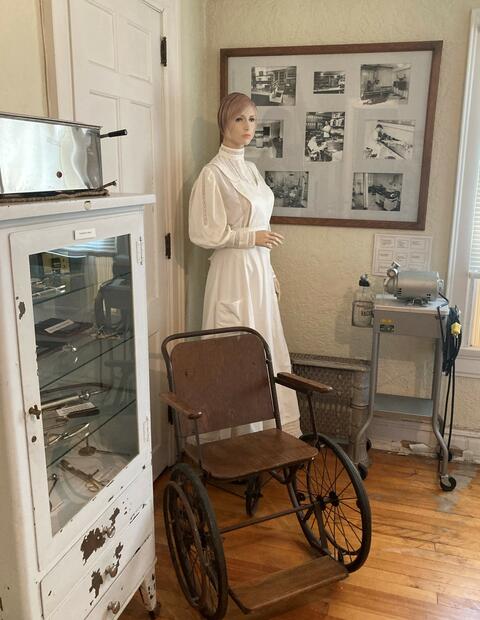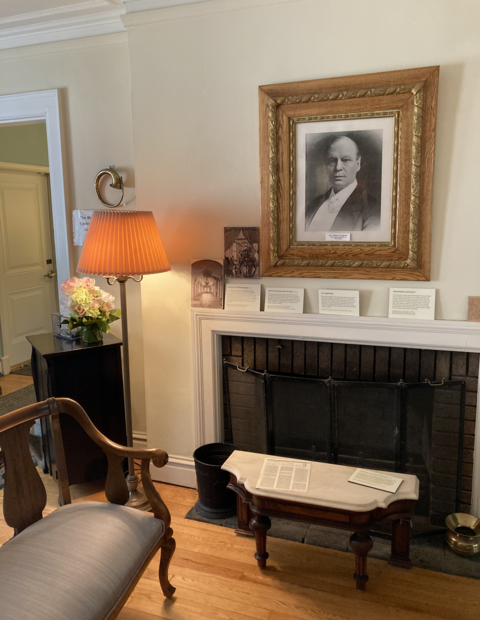Winnebago Mental Health Institute: Julaine Farrow Museum
The Julaine Farrow Museum preserves the history of Winnebago Mental Health Institute (WMHI). The museum is open to the public and maintained by volunteers. Learn more and come visit!
Where is the museum?
The Julaine Farrow Museum is in a house on our campus. The house is where the WMHI superintendent used to live.
Julaine Farrow Museum
4150 Sherman Rd.
Oshkosh, WI 54901
920-235-4910, ext. 2311
When is the museum open?
The museum is open to the public.
February through October
Thursdays
1:00 p.m.–3:30 p.m.
You also can make an appointment to see the museum outside normal hours. Call 920-235-4910, ext. 2311.
What’s in the museum?
The museum has 10 rooms with exhibits on two floors. Each room has drawings and photos. It also has artifacts and objects used over time at WMHI for:
- Daily care
- Diagnosis
- Treatment
- Other work
The first floor shows WMHI’s history. There are collections and furniture in each room. The second floor has spaces set up to look like:
- The bedroom of the medical superintendent.
- A hydrotherapy treatment room.
- A pharmacy.
- A surgery room.
How did the museum start?
It took years to get support for a museum about WMHI. This is the basic timeline for starting the museum:
- 1950s—The idea for a WMHI museum forms. A group of workers at what was then called Winnebago State Hospital want to share with the public the progress in mental health treatment.
- Early 1960s—The Board of Health and Social Services passes a resolution. It says the hospital must preserve what was then a blacksmith shop to be a museum.
- 1973—WMHI turns 100. Hospital staff increase their efforts for a museum. Three workers get credit for creating the museum:
- Julaine Farrow—Who the museum is named for. She was a nurse at the hospital. She was known as the unofficial hospital historian who collected many of the items in the museum.
- James O’Reilly—The hospital’s first volunteer services coordinator.
- Paul Theis—The hospital’s first management services director.
Diane Meschefske and Brenda Wiley helped carry on the work of this team.
- 1976—On Sept. 28, there’s a formal dedication of the museum in the blacksmith shop. Speakers include WMHI superintendent Dr. Darold Treffert and Board of Health and Social Services member Dr. William Studley.
- 1989—The museum moves from the blacksmith shop to the former superintendent’s house. This is where the museum sits today.
Who is Julaine Farrow?
Julaine Farrow (1917–1991) led the effort to open a museum to honor WMHI’s history.
Farrow grew up near WMHI. She was born in Oshkosh in 1917 and went to public schools there. In 1938, she graduated from Mercy Hospital School of Nursing. Later that year, she joined the staff at WMHI.
Farrow had a passion for nursing. She worked at WMHI for 36 years. In her early role as a staff nurse, she gave direct care to patients. Later, she moved into management roles.
In 1941, as acting director of nursing, she became an instructor and mentor at WMHI’s nursing school. She also served as acting director of nursing in 1960 and 1966. In her later years, she led many nurses who came to do their clinical nursing rotation. She also worked with students in the licensed practical nursing program.
Farrow’s other passion was to preserve the history of WMHI. To mark WMHI’s 100th year in 1973, she wrote a book. It detailed how the hospital came to be and its services. In the preface of the book, Dr. Donald Treffert (WMHI superintendent from 1964–1979) wrote:
“Her concern for the hospital and its history, nursing service and its responsibilities, the students and their training, has been superseded only by indefatigable concern for Winnebago's patients and their welfare. While the terms ‘ombudsman’ and ‘advocate’ may be new, that function and empathic concern have been carried out ably by her in all of her 36 years here.”
Farrow retired from WMHI in 1974. She still served as an active WMHI volunteer for many years. She gathered and maintained artifacts, objects, and papers about the WMHI’s history. She died in 1991.


